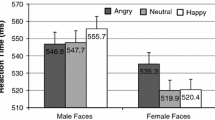Abstract
The goal of the present study was to assess preschoolers' beliefs about the frequency and intensity with which boys, girls, women, and men experience anger, sadness, and happiness. Sixty-seven middle-class preschool children (35 girls, 32 boys) were presented with drawings of adult and child figures of each sex, and were asked to rate how frequently and intensely the emotions were felt (91% of the children were white; the remainder were primarily black). Children's gender stereotyped beliefs were particularly strong for sadness and appeared to be based on a deficit-experience model for males. Sex of target differences also were found for children's beliefs about anger (favoring males). However, the sex difference in anger was based more on the degree to which anger is believed to be experienced rather than on differences in beliefs regarding males' and females' capacity to experience anger. Age of target differences were also found for sadness and anger, but not for happiness. It was concluded that preschoolers' beliefs about differences in emotions are complex, and vary as a function of the sex and age of the target person, and as a function of the specific emotion.
Similar content being viewed by others
References
Allen, J. G., & Haccoun, D. M. (1976). Sex differences in emotionality: A multidimensional approach. Human Relations, 29, 711–720.
Averill, J. R. (1982). Anger and aggression. New York: Springer-Verlag.
Birnbaum, D. W., & Chemelski, B. E. (1984). Preschoolers' inferences about gender and emotion: The mediation of emotionality stereotypes. Sex Roles, 10, 505–511.
Birnbaum, D. W., Nosanchuk, T. A., & Cross, W. L. (1980). Children's stereotypes about sex differences in emotionality. Sex Roles, 6, 435–443.
Brody, L. R. (1984). Sex and age variations in the quality and intensity of children's emotional attributions to hypothetical situations. Sex Roles, 11, 51–59.
Cochran, W. G. (1950). The comparison of percentages in matched samples. Biometrika, 37, 256–266.
Condry, J., & Condry, S. (1976). Sex differences: A study of the eye of the beholder. Child Development, 47, 812–819.
Covell, K., & Abramovitch, R. (1987). Understanding emotion in the family: Children's and parents' attributions of happiness, sadness, and anger. Child Development, 58, 985–991.
Cramer, P. (1983). Children's use of defense mechanisms in reaction to displeasure caused by others. Journal of Personality, 51, 78–94.
Daniels-Beirness, T. (1988). Measuring peer status in boys and girls: A problem of apples and oranges. In B. H. Schneider, G. Attili, J. Nadel, & R. P. Weissberg (Eds.), Social competence in developmental perspective. Boston: Kluwer Academic Publishers.
Eisenberg, N. (1986). Altruistic emotion, cognition, and behavior. Hillsdale, NJ: Erlbaum.
Eisenberg, N., Cialdini, R. B., McCreath, H., & Shell, R. (1989). Consistency based compliance in children: When and why do consistency procedures have immediate effects? International Journal of Behavioural Development, 12, 361–367.
Eisenberg, N., Fabes, R. A., Miller, P. A., Shell, R., Shea, C., & May-Plumlee, T. (1990). Preschoolers' vicarious emotional responding and their situational and dispositional prosocial behavior. Merrill-Palmer Quarterly, 36, 507–529.
Fabes, R. A., & Martin, C. L. (1991). Gender and age stereotypes of emotionality. Personality and Social Psychology Bulletin, 17, 532–540.
Fabes, R. A., Eisenberg, N., McCormick, S. E., & Wilson, M. S. (1988). Preschoolers' attributions of the situational determinants of others' naturally occurring emotions. Developmental Psychology, 24, 376–385.
Glasberg, R., & Aboud, F. (1982). Keeping one's distance from sadness: Children's self-reports of emotional experience. Developmental Psychology, 18, 287–293.
Gnepp, J. (1983). Children's social sensitivity: Inferring emotions from conflicting cues. Developmental Psychology, 19, 805–814.
Harris, P. L., Olthof, T., & Terwogt, M. M. (1981). Children's knowledge of emotion. Journal of Child Psychiatry and Psychology, 22, 247–261.
Haugh, S. S., Hoffman, C. D., & Cowan, G. (1980). The eye of the very young beholder: Sex typing infants by young children. Child Development, 51, 598–600.
Hoffner, C., & Badzinski, D. M. (1989). Children's integration of facial and situational cues to emotion. Child Development, 60, 411–422.
Lamb, M. E., Easterbrooks, M. A., & Holden, G. W. (1980). Reinforcement and punishment among preschoolers: Characteristics, effects, and correlates. Child Development, 51, 1230–1236.
Maccoby, E. E., & Jacklin, C. N. (1975). The psychology of sex differences. Stanford, CA: Stanford University Press.
Martin, C. L. (1992). The role of cognition in understanding gender effects. Advances in Child Development and Behavior, 23, 113–149.
Strayer, J. (1980). A naturalistic study of empathic behaviors and their relation to affective states and perspective-taking skills in preschool children. Child Development, 51, 815–822.
Zucker, K. J., Wilson, D. N., & Stern, A. (April, 1985). Children's appraisals of sex-typed behavior in their peers. Paper presented at the meeting of the Society for Research in Child Development, Toronto, Canada.
Author information
Authors and Affiliations
Additional information
Partial support for Richard Fabes was provided by a grant from the National Science Foundation (BNS-8807784). Partial support for Carol Martin was provided by a Women's Studies Research Award (CM1-1001) and a Faculty Grant in Aid (RWR-B658) from Arizona State University. The authors would like to thank Anita Petitti, Dennis Barrett, Amy Vogelson, Melinda Deacon, Kris Hughes, Amy Secklin, Hilary Rose, Melanie Smith, and Melinda Smith for their assistance with data collection and stimulus preparation. Thanks also goes to the teachers, staff, and children at the Arizona State University Child Laboratory Programs.
Rights and permissions
About this article
Cite this article
Karbon, M., Fabes, R.A., Carlo, G. et al. Preschoolers' beliefs about sex and age differences in emotionality. Sex Roles 27, 377–390 (1992). https://doi.org/10.1007/BF00289946
Issue Date:
DOI: https://doi.org/10.1007/BF00289946




